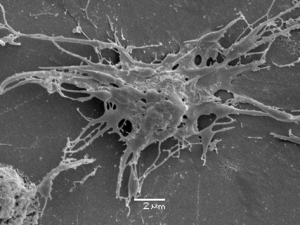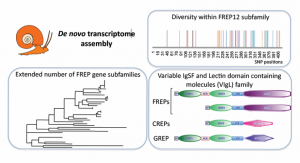Highly variable proteins in invertebrates
185/333 proteins in Sea urchins
During my PhD at Macquarie University (in Sydney, Australia), I used the Sea urchin Strongylocentrotus purpuratus to study the lineage specific expansion of paralogous genes families in invertebrates as a mechanism of adaptation to the diversity of parasites. I was supervised by David A, Raftos and Sham V. Nair and I am very grateful for their help throughout that project.

Thanks to the recently sequenced genome, I used proteomics approaches to study the sea urchin immune response to different pathogens. In the first instance, I described the proteome of sea urchin coelomocytes (immune cells) and then the sea urchin immune response over time. Next I focused on a newly discovered family of highly variable molecules, the 185/333 proteins and I studied their diversity and their expression profile in response to diverse pathogens. I also used microscopy approaches, including gold immunolabelling to localize these peculiar proteins within different coelomocyte types.
Fibrinogen-related proteins (FREPs) in Biomphalaria glabrata
During my Postdoc in the Universite de Perpignan (France), I used next generation sequencing approaches to investigate the diversity of another peculiar family of highly diversified proteins in an invertebrate, the FREPs molecules in the mollusk Biomphalaria gla brata. I also discovered that FREPs are part of an extended family of variable immunoglobulin and lectin domain containing molecules that we called VIgL. The new members, C-type lectin-related proteins (CREPs) and Galectin-related proteins (GREP) are not as diversified as FREPs. I also participated in studies aiming at understanding the mechanisms responsible for the specific priming response of B. glabrata to its obligate parasite, Schistosoma mansoni.
brata. I also discovered that FREPs are part of an extended family of variable immunoglobulin and lectin domain containing molecules that we called VIgL. The new members, C-type lectin-related proteins (CREPs) and Galectin-related proteins (GREP) are not as diversified as FREPs. I also participated in studies aiming at understanding the mechanisms responsible for the specific priming response of B. glabrata to its obligate parasite, Schistosoma mansoni.
Effect of abiotic stress on the resistance of the cnidarian Pocillopora damicornis to Vibrio coralliilyticus
In the context of global change, the two factors that impact the most marine organisms are the sea water temperature and acidity. In the Universite of Perpignan, we have tested the effect of these two factors on the coral physiology and on its susceptibility to Vibrio coralliilyticus. An overall mobilization of energy reserves and transcriptomic remodelling in respond to abiotic stress greatly impairs the coral immune system, and hence its ability to resist to parasite exposure. In addition, we showed that temperature dependent virulence mechanisms of V. coralliilyticus induces a targeted immunosuppression that can explain its high pathogenicity when the temperature increases.

featured in National Geographic – Mindsuckers by Carl Zimmer (http://ngm.nationalgeographic.com/2014/11/mindsuckers/zimmer-text)
The behavioral manipulation of the ladybeetle Coleomegilla maculata by the parasitic wasp Dinocampus coccinellae
Numerous parasites manipulate the behavior of their hosts to pursue their life cycle or to improve their fitness, but in most cases the molecular mechanisms that are responsible are unknown. In this model, we have discovered that the parasitic wasp Dinocampus coccinellae uses a neurotropic virus, the DcPV (which stands for Dinocampus coccinellae Paralysis Virus) as a biological weapon to manipulate the behavior of its host. Females deposit their eggs in the abdomen of the ladybeetle host, and during larval development, the parasite feeds off the ladybeetle fat body. The virus replicates actively in larva and invade the ladybeetle nervous system. After about 20 days, the larva extracts itself from the ladybeetle abdomen and tiss a cocoon between its legs. The ladybeetle is then paralyzed (most probably because of a virus induced neurodegenerescence) and acts as a bodyguard that protects the pupae against predators, such as crickets or jumping spiders. In the cocoon, the parasite pupates into an adult wasp. Interestingly, the ladybeetle immune system will then eliminate the virus. The ladybeetle recovers from the paralysis and abandons the empty cocoon. This discovery resulted from a successful collaboration between teams from the Universite de Perpignan, the Universite de Montpellier and the Universite de Montreal.
The reproductive system of oysters
During my postdoc at the Universite de Caen and Ifremer Brest, I participated in the development of a new oyster microarray and I used it to study gametogenesis in diploid and triploid oysters. Oysters invest a lot of energy in their reproduction in summer, which has great consequences on all other physiological functions, including immunity. However, triploid oyster do not develop a functional gonad, which may explain their better survival to some diseases. The thorough description of the genes differentially expressed in female and male diploid and triploid oysters will help deciphering the mechanisms behind oysters strong investment in reproduction.